Assessment 2 Report: Healthcare, Leadership and Culture
VerifiedAdded on 2019/11/12
|16
|3419
|443
Report
AI Summary
This report provides a comprehensive analysis of key aspects within healthcare, focusing on clinical governance, leadership, organizational culture, and their practical applications. The first part examines the importance of consumer participation in healthcare services, emphasizing its impact on patient outcomes, access, and quality, alongside strategies for engaging patients, including feedback mechanisms and promoting patient rights. The second part focuses on the role of a Registered Nurse (RN) in fostering patient engagement and trust, including educating patients about their conditions and the care process. The report also addresses the National Safety and Quality Health Service (NSQHS) Standard-3 on infection control, highlighting the importance of maintaining cleanliness and applying proper sterilization techniques. Furthermore, the report explores leadership qualities in nursing, particularly mentorship, and strategies for effective time management and professional development. Finally, the report examines the concept of a learning organization in healthcare, emphasizing its role in fostering innovation, accountability, and improved patient-clinician partnerships. It also outlines the contributions of a registered nurse to creating such an environment by setting learning goals and promoting knowledge sharing.
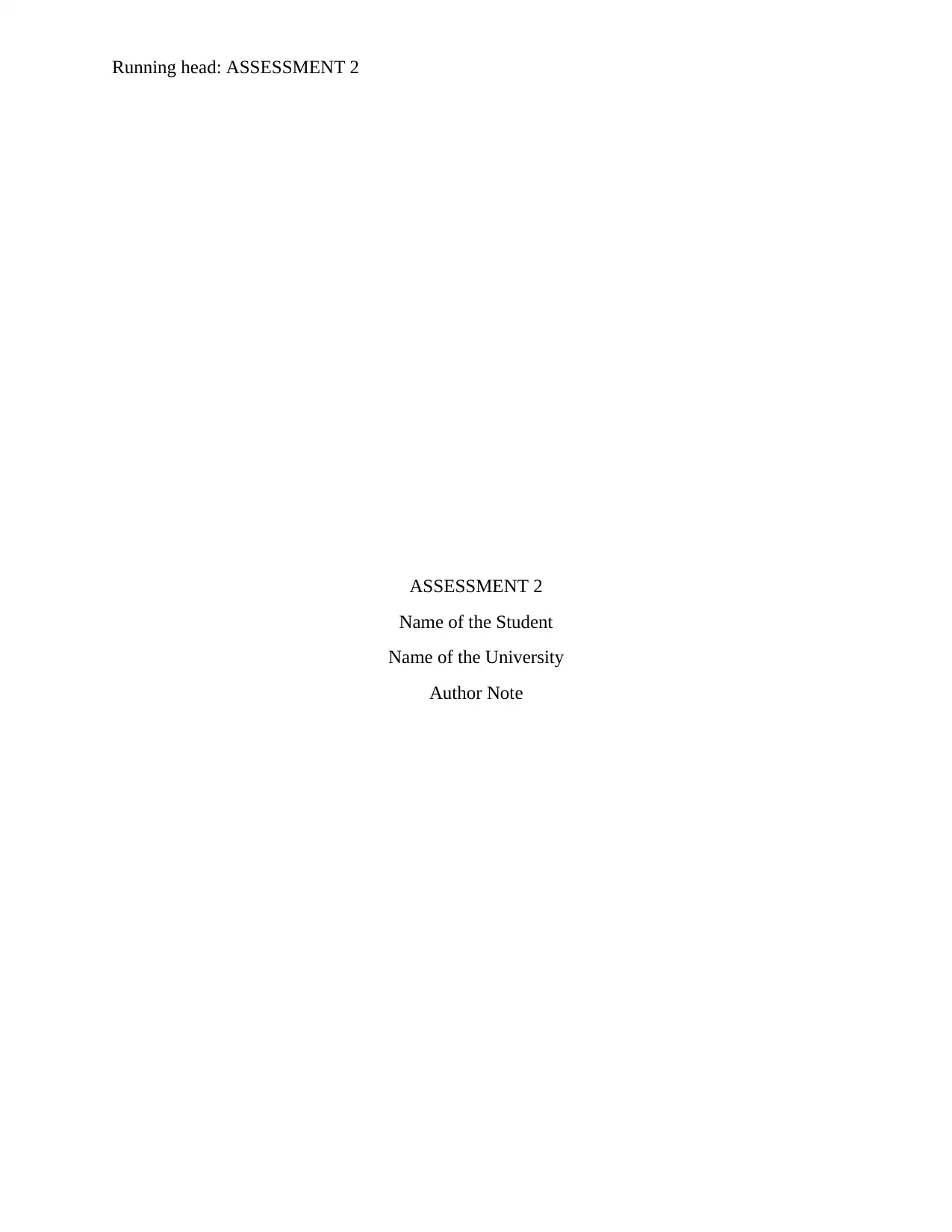
Running head: ASSESSMENT 2
ASSESSMENT 2
Name of the Student
Name of the University
Author Note
ASSESSMENT 2
Name of the Student
Name of the University
Author Note
Paraphrase This Document
Need a fresh take? Get an instant paraphrase of this document with our AI Paraphraser

1ASSESSMENT 2
Clinical Governance
Part 1
Consumer participation in healthcare service is the most important foundation of primary
health service. The benefits include better health outcomes, relevance, justice, access to services,
quality of healthcare, and so on. According to Renedo et. al. (2015) active participation of
consumers, makes the service more effective and accessible and consumers feel empowered to
make decisions.
According to Ricciardi et. al. (2013), involving patients, who are concerned about their
health should be involved in the process as they will be able to participate in heath and
preventive measures. Furthermore, they will be able to self-manage to achieve better outcomes.
According to a study on patients with chronic diseases, it was found that “aware” patients were
three times less likely to suffer from a negative health impact or medical error than those who are
not confident about skills and knowledge of process.
According to Finkelstein et. al. (2012), another way to involve consumer to healthcare is
by receiving feedbacks from consumers regarding the service they got or what changes they want
to imply. Their rights and responsibilities should be promoted to staffs, carers, and clinicians to
avoid any discrimination.
Clinical Governance
Part 1
Consumer participation in healthcare service is the most important foundation of primary
health service. The benefits include better health outcomes, relevance, justice, access to services,
quality of healthcare, and so on. According to Renedo et. al. (2015) active participation of
consumers, makes the service more effective and accessible and consumers feel empowered to
make decisions.
According to Ricciardi et. al. (2013), involving patients, who are concerned about their
health should be involved in the process as they will be able to participate in heath and
preventive measures. Furthermore, they will be able to self-manage to achieve better outcomes.
According to a study on patients with chronic diseases, it was found that “aware” patients were
three times less likely to suffer from a negative health impact or medical error than those who are
not confident about skills and knowledge of process.
According to Finkelstein et. al. (2012), another way to involve consumer to healthcare is
by receiving feedbacks from consumers regarding the service they got or what changes they want
to imply. Their rights and responsibilities should be promoted to staffs, carers, and clinicians to
avoid any discrimination.
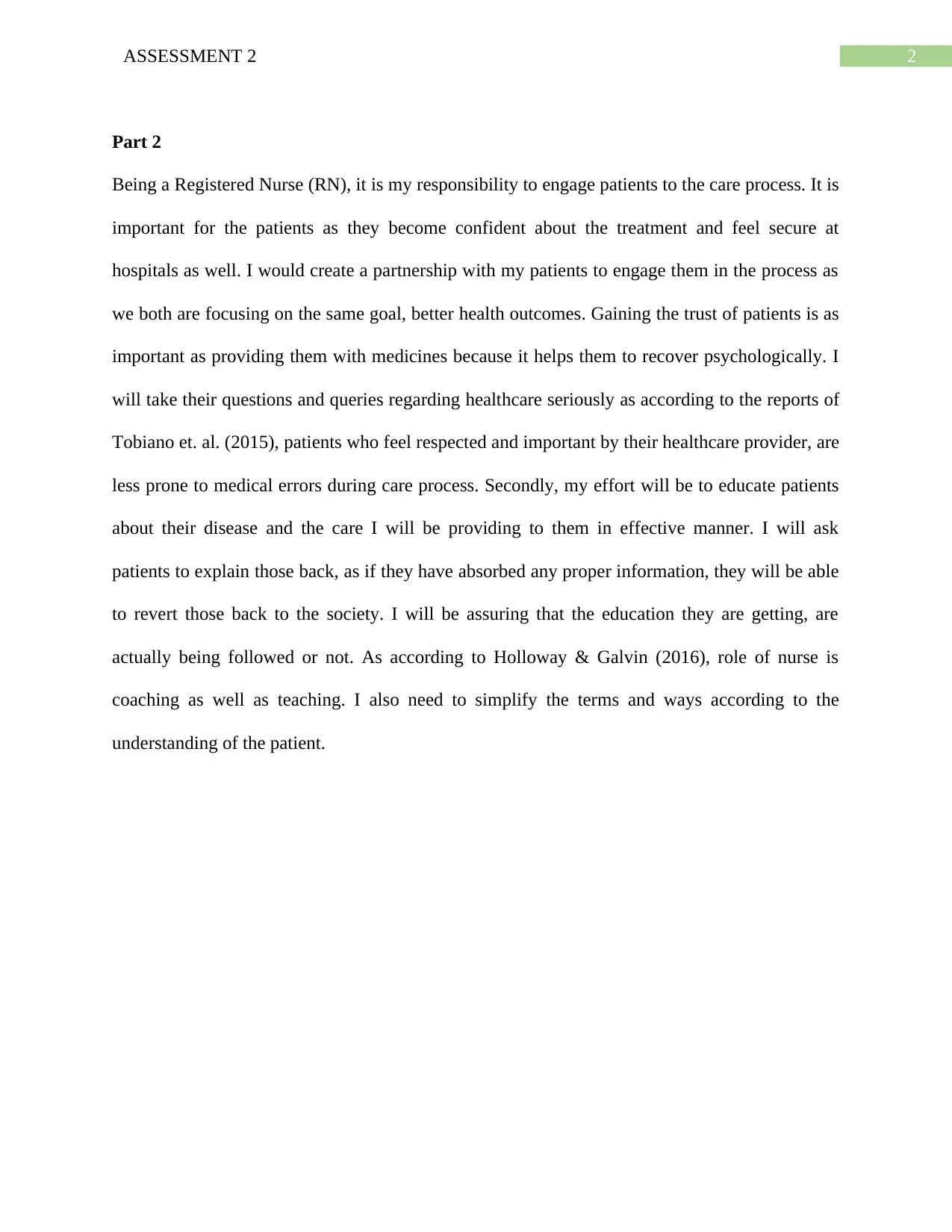
2ASSESSMENT 2
Part 2
Being a Registered Nurse (RN), it is my responsibility to engage patients to the care process. It is
important for the patients as they become confident about the treatment and feel secure at
hospitals as well. I would create a partnership with my patients to engage them in the process as
we both are focusing on the same goal, better health outcomes. Gaining the trust of patients is as
important as providing them with medicines because it helps them to recover psychologically. I
will take their questions and queries regarding healthcare seriously as according to the reports of
Tobiano et. al. (2015), patients who feel respected and important by their healthcare provider, are
less prone to medical errors during care process. Secondly, my effort will be to educate patients
about their disease and the care I will be providing to them in effective manner. I will ask
patients to explain those back, as if they have absorbed any proper information, they will be able
to revert those back to the society. I will be assuring that the education they are getting, are
actually being followed or not. As according to Holloway & Galvin (2016), role of nurse is
coaching as well as teaching. I also need to simplify the terms and ways according to the
understanding of the patient.
Part 2
Being a Registered Nurse (RN), it is my responsibility to engage patients to the care process. It is
important for the patients as they become confident about the treatment and feel secure at
hospitals as well. I would create a partnership with my patients to engage them in the process as
we both are focusing on the same goal, better health outcomes. Gaining the trust of patients is as
important as providing them with medicines because it helps them to recover psychologically. I
will take their questions and queries regarding healthcare seriously as according to the reports of
Tobiano et. al. (2015), patients who feel respected and important by their healthcare provider, are
less prone to medical errors during care process. Secondly, my effort will be to educate patients
about their disease and the care I will be providing to them in effective manner. I will ask
patients to explain those back, as if they have absorbed any proper information, they will be able
to revert those back to the society. I will be assuring that the education they are getting, are
actually being followed or not. As according to Holloway & Galvin (2016), role of nurse is
coaching as well as teaching. I also need to simplify the terms and ways according to the
understanding of the patient.
⊘ This is a preview!⊘
Do you want full access?
Subscribe today to unlock all pages.

Trusted by 1+ million students worldwide
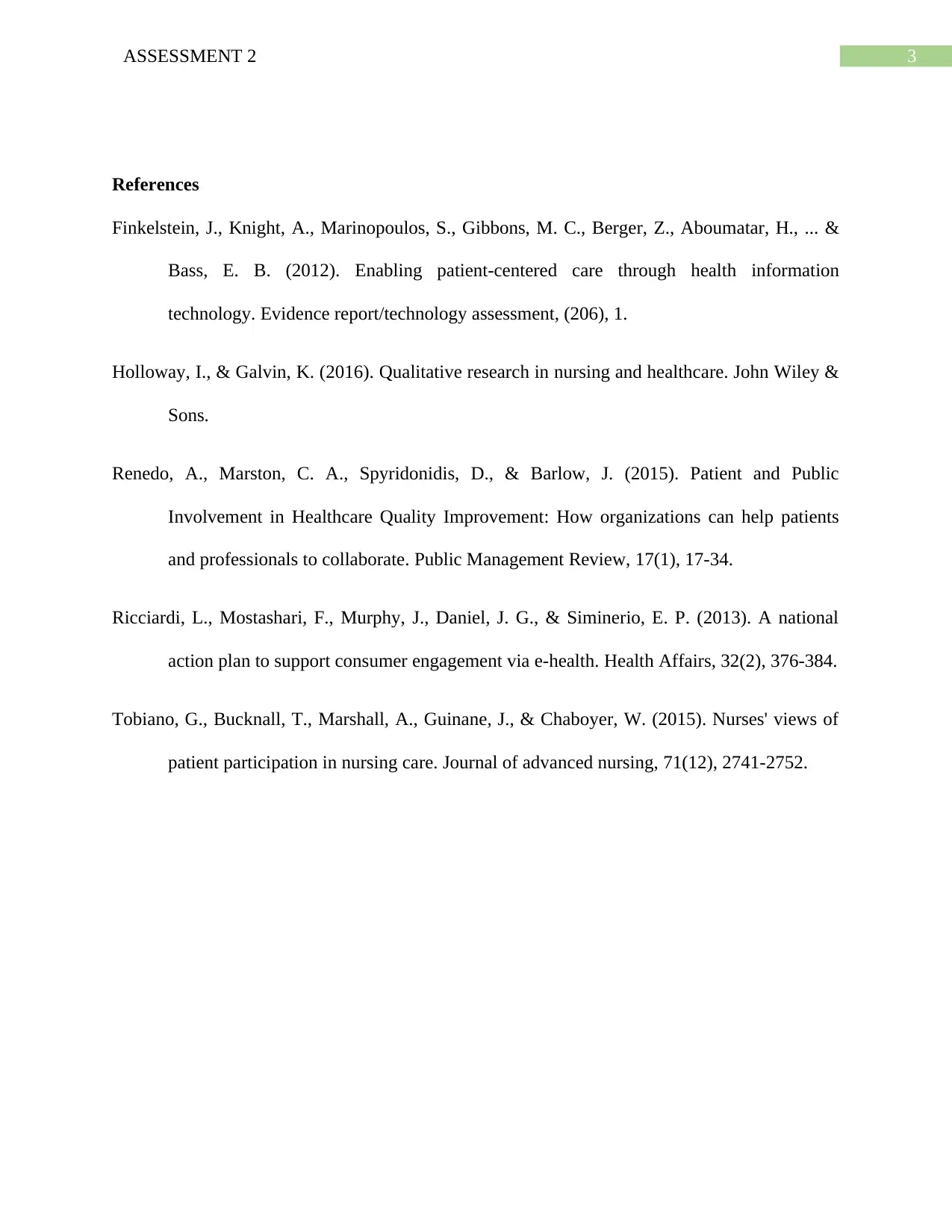
3ASSESSMENT 2
References
Finkelstein, J., Knight, A., Marinopoulos, S., Gibbons, M. C., Berger, Z., Aboumatar, H., ... &
Bass, E. B. (2012). Enabling patient-centered care through health information
technology. Evidence report/technology assessment, (206), 1.
Holloway, I., & Galvin, K. (2016). Qualitative research in nursing and healthcare. John Wiley &
Sons.
Renedo, A., Marston, C. A., Spyridonidis, D., & Barlow, J. (2015). Patient and Public
Involvement in Healthcare Quality Improvement: How organizations can help patients
and professionals to collaborate. Public Management Review, 17(1), 17-34.
Ricciardi, L., Mostashari, F., Murphy, J., Daniel, J. G., & Siminerio, E. P. (2013). A national
action plan to support consumer engagement via e-health. Health Affairs, 32(2), 376-384.
Tobiano, G., Bucknall, T., Marshall, A., Guinane, J., & Chaboyer, W. (2015). Nurses' views of
patient participation in nursing care. Journal of advanced nursing, 71(12), 2741-2752.
References
Finkelstein, J., Knight, A., Marinopoulos, S., Gibbons, M. C., Berger, Z., Aboumatar, H., ... &
Bass, E. B. (2012). Enabling patient-centered care through health information
technology. Evidence report/technology assessment, (206), 1.
Holloway, I., & Galvin, K. (2016). Qualitative research in nursing and healthcare. John Wiley &
Sons.
Renedo, A., Marston, C. A., Spyridonidis, D., & Barlow, J. (2015). Patient and Public
Involvement in Healthcare Quality Improvement: How organizations can help patients
and professionals to collaborate. Public Management Review, 17(1), 17-34.
Ricciardi, L., Mostashari, F., Murphy, J., Daniel, J. G., & Siminerio, E. P. (2013). A national
action plan to support consumer engagement via e-health. Health Affairs, 32(2), 376-384.
Tobiano, G., Bucknall, T., Marshall, A., Guinane, J., & Chaboyer, W. (2015). Nurses' views of
patient participation in nursing care. Journal of advanced nursing, 71(12), 2741-2752.
Paraphrase This Document
Need a fresh take? Get an instant paraphrase of this document with our AI Paraphraser
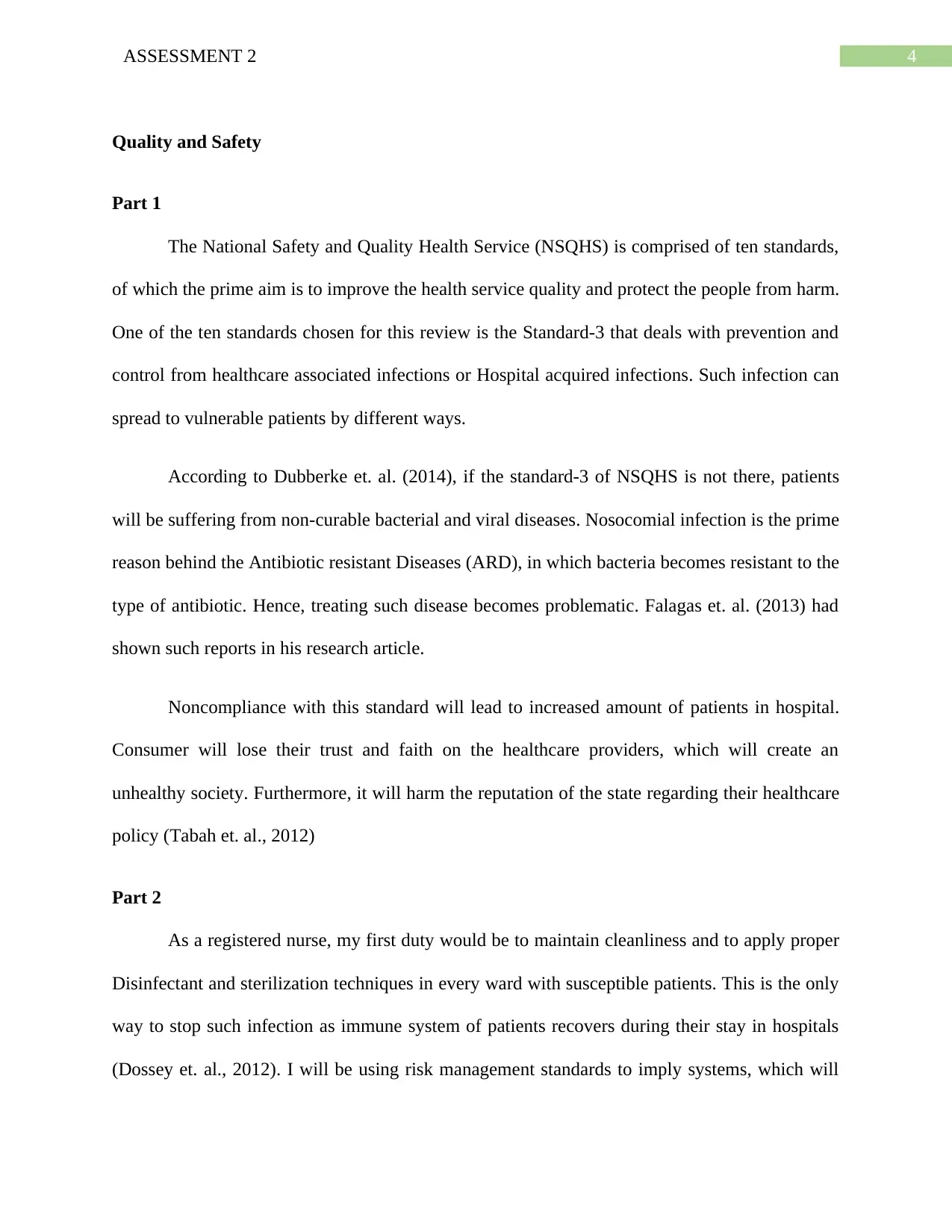
4ASSESSMENT 2
Quality and Safety
Part 1
The National Safety and Quality Health Service (NSQHS) is comprised of ten standards,
of which the prime aim is to improve the health service quality and protect the people from harm.
One of the ten standards chosen for this review is the Standard-3 that deals with prevention and
control from healthcare associated infections or Hospital acquired infections. Such infection can
spread to vulnerable patients by different ways.
According to Dubberke et. al. (2014), if the standard-3 of NSQHS is not there, patients
will be suffering from non-curable bacterial and viral diseases. Nosocomial infection is the prime
reason behind the Antibiotic resistant Diseases (ARD), in which bacteria becomes resistant to the
type of antibiotic. Hence, treating such disease becomes problematic. Falagas et. al. (2013) had
shown such reports in his research article.
Noncompliance with this standard will lead to increased amount of patients in hospital.
Consumer will lose their trust and faith on the healthcare providers, which will create an
unhealthy society. Furthermore, it will harm the reputation of the state regarding their healthcare
policy (Tabah et. al., 2012)
Part 2
As a registered nurse, my first duty would be to maintain cleanliness and to apply proper
Disinfectant and sterilization techniques in every ward with susceptible patients. This is the only
way to stop such infection as immune system of patients recovers during their stay in hospitals
(Dossey et. al., 2012). I will be using risk management standards to imply systems, which will
Quality and Safety
Part 1
The National Safety and Quality Health Service (NSQHS) is comprised of ten standards,
of which the prime aim is to improve the health service quality and protect the people from harm.
One of the ten standards chosen for this review is the Standard-3 that deals with prevention and
control from healthcare associated infections or Hospital acquired infections. Such infection can
spread to vulnerable patients by different ways.
According to Dubberke et. al. (2014), if the standard-3 of NSQHS is not there, patients
will be suffering from non-curable bacterial and viral diseases. Nosocomial infection is the prime
reason behind the Antibiotic resistant Diseases (ARD), in which bacteria becomes resistant to the
type of antibiotic. Hence, treating such disease becomes problematic. Falagas et. al. (2013) had
shown such reports in his research article.
Noncompliance with this standard will lead to increased amount of patients in hospital.
Consumer will lose their trust and faith on the healthcare providers, which will create an
unhealthy society. Furthermore, it will harm the reputation of the state regarding their healthcare
policy (Tabah et. al., 2012)
Part 2
As a registered nurse, my first duty would be to maintain cleanliness and to apply proper
Disinfectant and sterilization techniques in every ward with susceptible patients. This is the only
way to stop such infection as immune system of patients recovers during their stay in hospitals
(Dossey et. al., 2012). I will be using risk management standards to imply systems, which will

5ASSESSMENT 2
maintain a hygienic, sanitized and clean environment for both workers and patients. I will make
all the patients aware of such infection by educating them about the organizations corporate and
clinical infection risks. I will try to assess the patient’s condition and will try to provide them
proper placement according to their health condition and ability to sustain hospital-acquired
infection. As according to Borer et. al. (2012), it is important to undertake a risk factor analysis
based on the transmission based precaution including cleaning status, environmental airflow and
equipment requirement and so on. furthermore, to prevent such infection outside the hospital I
will be keep a track of admission of patients with severe infection, their treatment and transfer or
discharge so that I can educate others with the symptoms and patient outcomes of that disease. I
will follow all the techniques and protocols to maintain an aseptic condition within the clinical
institute.
maintain a hygienic, sanitized and clean environment for both workers and patients. I will make
all the patients aware of such infection by educating them about the organizations corporate and
clinical infection risks. I will try to assess the patient’s condition and will try to provide them
proper placement according to their health condition and ability to sustain hospital-acquired
infection. As according to Borer et. al. (2012), it is important to undertake a risk factor analysis
based on the transmission based precaution including cleaning status, environmental airflow and
equipment requirement and so on. furthermore, to prevent such infection outside the hospital I
will be keep a track of admission of patients with severe infection, their treatment and transfer or
discharge so that I can educate others with the symptoms and patient outcomes of that disease. I
will follow all the techniques and protocols to maintain an aseptic condition within the clinical
institute.
⊘ This is a preview!⊘
Do you want full access?
Subscribe today to unlock all pages.

Trusted by 1+ million students worldwide
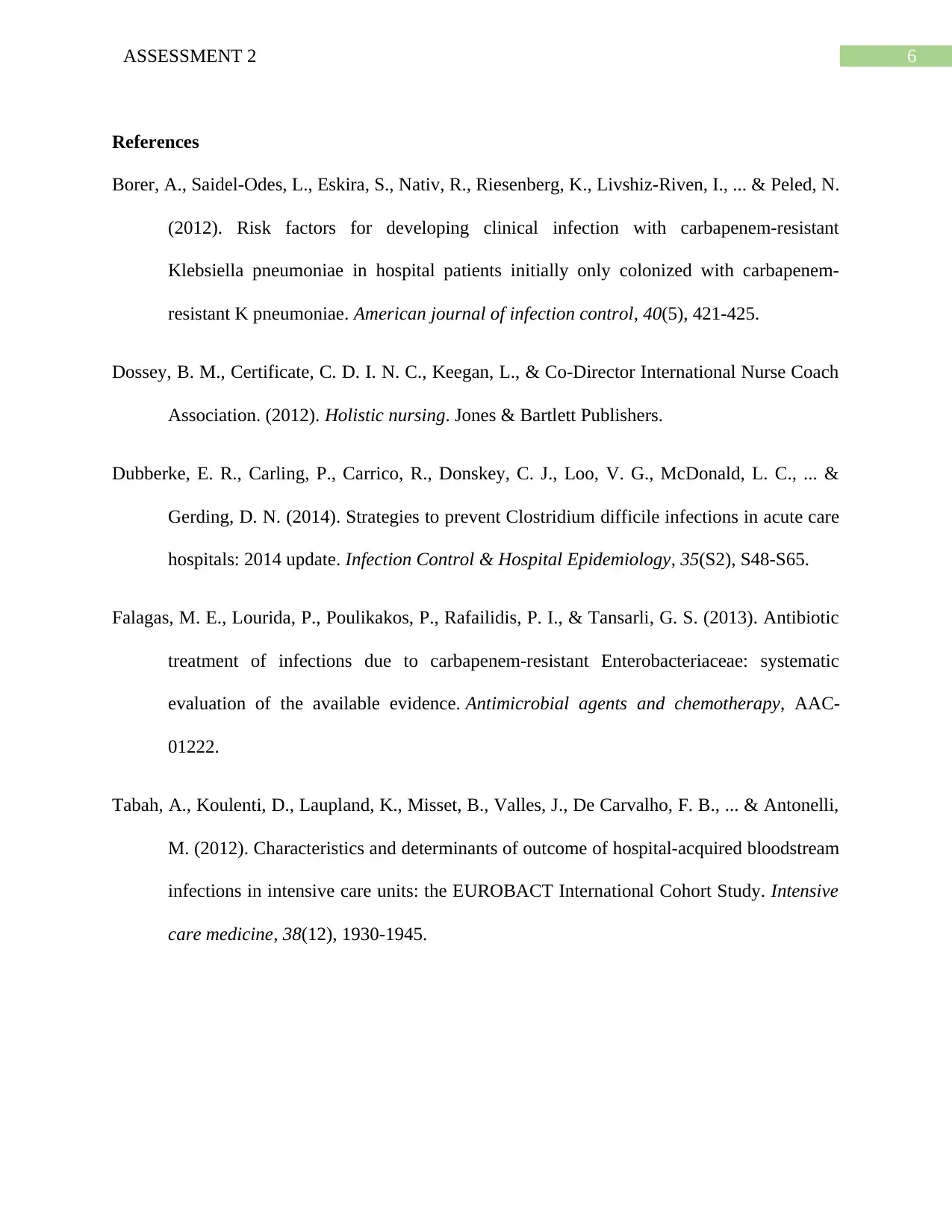
6ASSESSMENT 2
References
Borer, A., Saidel-Odes, L., Eskira, S., Nativ, R., Riesenberg, K., Livshiz-Riven, I., ... & Peled, N.
(2012). Risk factors for developing clinical infection with carbapenem-resistant
Klebsiella pneumoniae in hospital patients initially only colonized with carbapenem-
resistant K pneumoniae. American journal of infection control, 40(5), 421-425.
Dossey, B. M., Certificate, C. D. I. N. C., Keegan, L., & Co-Director International Nurse Coach
Association. (2012). Holistic nursing. Jones & Bartlett Publishers.
Dubberke, E. R., Carling, P., Carrico, R., Donskey, C. J., Loo, V. G., McDonald, L. C., ... &
Gerding, D. N. (2014). Strategies to prevent Clostridium difficile infections in acute care
hospitals: 2014 update. Infection Control & Hospital Epidemiology, 35(S2), S48-S65.
Falagas, M. E., Lourida, P., Poulikakos, P., Rafailidis, P. I., & Tansarli, G. S. (2013). Antibiotic
treatment of infections due to carbapenem-resistant Enterobacteriaceae: systematic
evaluation of the available evidence. Antimicrobial agents and chemotherapy, AAC-
01222.
Tabah, A., Koulenti, D., Laupland, K., Misset, B., Valles, J., De Carvalho, F. B., ... & Antonelli,
M. (2012). Characteristics and determinants of outcome of hospital-acquired bloodstream
infections in intensive care units: the EUROBACT International Cohort Study. Intensive
care medicine, 38(12), 1930-1945.
References
Borer, A., Saidel-Odes, L., Eskira, S., Nativ, R., Riesenberg, K., Livshiz-Riven, I., ... & Peled, N.
(2012). Risk factors for developing clinical infection with carbapenem-resistant
Klebsiella pneumoniae in hospital patients initially only colonized with carbapenem-
resistant K pneumoniae. American journal of infection control, 40(5), 421-425.
Dossey, B. M., Certificate, C. D. I. N. C., Keegan, L., & Co-Director International Nurse Coach
Association. (2012). Holistic nursing. Jones & Bartlett Publishers.
Dubberke, E. R., Carling, P., Carrico, R., Donskey, C. J., Loo, V. G., McDonald, L. C., ... &
Gerding, D. N. (2014). Strategies to prevent Clostridium difficile infections in acute care
hospitals: 2014 update. Infection Control & Hospital Epidemiology, 35(S2), S48-S65.
Falagas, M. E., Lourida, P., Poulikakos, P., Rafailidis, P. I., & Tansarli, G. S. (2013). Antibiotic
treatment of infections due to carbapenem-resistant Enterobacteriaceae: systematic
evaluation of the available evidence. Antimicrobial agents and chemotherapy, AAC-
01222.
Tabah, A., Koulenti, D., Laupland, K., Misset, B., Valles, J., De Carvalho, F. B., ... & Antonelli,
M. (2012). Characteristics and determinants of outcome of hospital-acquired bloodstream
infections in intensive care units: the EUROBACT International Cohort Study. Intensive
care medicine, 38(12), 1930-1945.
Paraphrase This Document
Need a fresh take? Get an instant paraphrase of this document with our AI Paraphraser

7ASSESSMENT 2
Leadership and Management
Part 1
It is always inspiring to have someone with dynamic leadership quality around, as it is
easier to make consensus decisions, with a calculated and caring approach. For nurses as well,
Leadership quality is a key skill. Registered nurses are known as leader of patient healthcare and
they implement different procedures that improves the health of patient by providing them with
comfort. Nurses should be working in cooperation to coordinate and inspire the entire team of
healthcare providers, families of the patient and the patient himself to improve his health
conditions. (Laschinger, Wong & Grau, 2013)
According to Doody and Doody (2012), the first leadership quality a registered nurse
should have is mentorship. There are different ways to motivate different people hence, it is
important to understand the way to empower and motivate each individual. Registered nurses
must take an activity session in which they educate others with some work related or ethic
related topic, others should take those notes in their activity log for further sessions.
Another leadership quality, one registered nurse must have is, professional socialization.
Nurses have the power to change behavior and provide the environment in which future
competent and influential nurses can be prepared. They have to be the role model to provide
effective socialization experience to transfer the ethical values beliefs, and proper nursing skills
to the future staffs (Hutchinson & Jackson, 2013).
Leadership and Management
Part 1
It is always inspiring to have someone with dynamic leadership quality around, as it is
easier to make consensus decisions, with a calculated and caring approach. For nurses as well,
Leadership quality is a key skill. Registered nurses are known as leader of patient healthcare and
they implement different procedures that improves the health of patient by providing them with
comfort. Nurses should be working in cooperation to coordinate and inspire the entire team of
healthcare providers, families of the patient and the patient himself to improve his health
conditions. (Laschinger, Wong & Grau, 2013)
According to Doody and Doody (2012), the first leadership quality a registered nurse
should have is mentorship. There are different ways to motivate different people hence, it is
important to understand the way to empower and motivate each individual. Registered nurses
must take an activity session in which they educate others with some work related or ethic
related topic, others should take those notes in their activity log for further sessions.
Another leadership quality, one registered nurse must have is, professional socialization.
Nurses have the power to change behavior and provide the environment in which future
competent and influential nurses can be prepared. They have to be the role model to provide
effective socialization experience to transfer the ethical values beliefs, and proper nursing skills
to the future staffs (Hutchinson & Jackson, 2013).
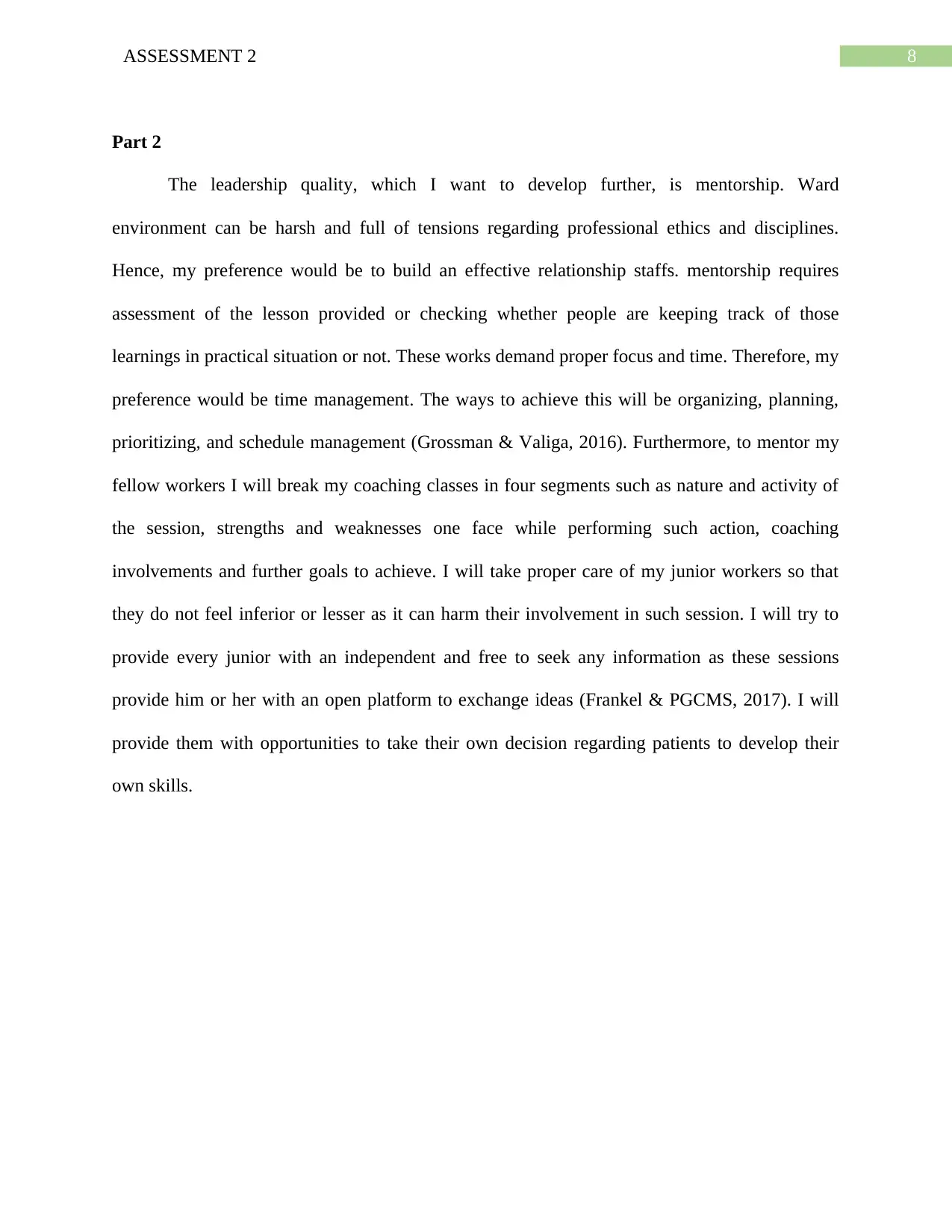
8ASSESSMENT 2
Part 2
The leadership quality, which I want to develop further, is mentorship. Ward
environment can be harsh and full of tensions regarding professional ethics and disciplines.
Hence, my preference would be to build an effective relationship staffs. mentorship requires
assessment of the lesson provided or checking whether people are keeping track of those
learnings in practical situation or not. These works demand proper focus and time. Therefore, my
preference would be time management. The ways to achieve this will be organizing, planning,
prioritizing, and schedule management (Grossman & Valiga, 2016). Furthermore, to mentor my
fellow workers I will break my coaching classes in four segments such as nature and activity of
the session, strengths and weaknesses one face while performing such action, coaching
involvements and further goals to achieve. I will take proper care of my junior workers so that
they do not feel inferior or lesser as it can harm their involvement in such session. I will try to
provide every junior with an independent and free to seek any information as these sessions
provide him or her with an open platform to exchange ideas (Frankel & PGCMS, 2017). I will
provide them with opportunities to take their own decision regarding patients to develop their
own skills.
Part 2
The leadership quality, which I want to develop further, is mentorship. Ward
environment can be harsh and full of tensions regarding professional ethics and disciplines.
Hence, my preference would be to build an effective relationship staffs. mentorship requires
assessment of the lesson provided or checking whether people are keeping track of those
learnings in practical situation or not. These works demand proper focus and time. Therefore, my
preference would be time management. The ways to achieve this will be organizing, planning,
prioritizing, and schedule management (Grossman & Valiga, 2016). Furthermore, to mentor my
fellow workers I will break my coaching classes in four segments such as nature and activity of
the session, strengths and weaknesses one face while performing such action, coaching
involvements and further goals to achieve. I will take proper care of my junior workers so that
they do not feel inferior or lesser as it can harm their involvement in such session. I will try to
provide every junior with an independent and free to seek any information as these sessions
provide him or her with an open platform to exchange ideas (Frankel & PGCMS, 2017). I will
provide them with opportunities to take their own decision regarding patients to develop their
own skills.
⊘ This is a preview!⊘
Do you want full access?
Subscribe today to unlock all pages.

Trusted by 1+ million students worldwide
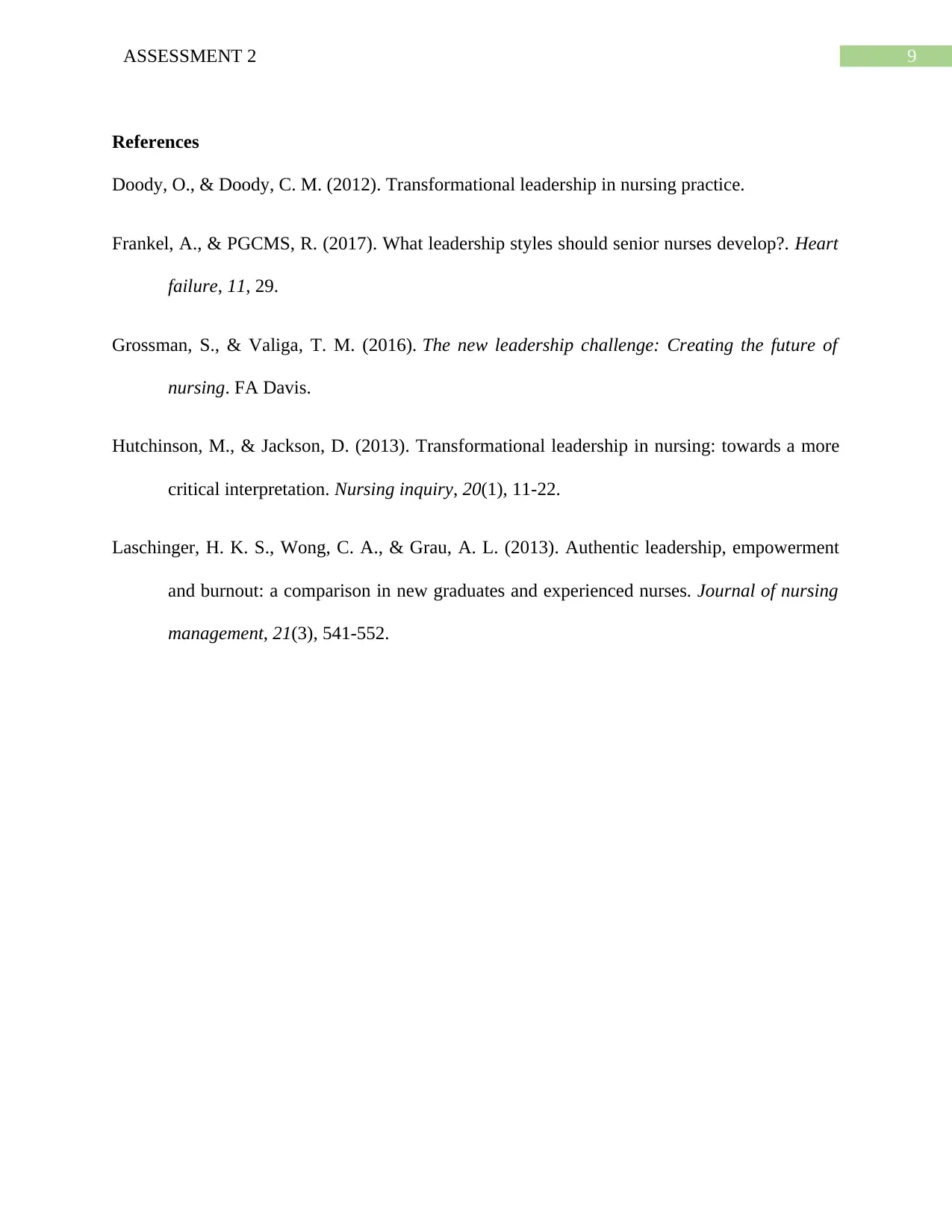
9ASSESSMENT 2
References
Doody, O., & Doody, C. M. (2012). Transformational leadership in nursing practice.
Frankel, A., & PGCMS, R. (2017). What leadership styles should senior nurses develop?. Heart
failure, 11, 29.
Grossman, S., & Valiga, T. M. (2016). The new leadership challenge: Creating the future of
nursing. FA Davis.
Hutchinson, M., & Jackson, D. (2013). Transformational leadership in nursing: towards a more
critical interpretation. Nursing inquiry, 20(1), 11-22.
Laschinger, H. K. S., Wong, C. A., & Grau, A. L. (2013). Authentic leadership, empowerment
and burnout: a comparison in new graduates and experienced nurses. Journal of nursing
management, 21(3), 541-552.
References
Doody, O., & Doody, C. M. (2012). Transformational leadership in nursing practice.
Frankel, A., & PGCMS, R. (2017). What leadership styles should senior nurses develop?. Heart
failure, 11, 29.
Grossman, S., & Valiga, T. M. (2016). The new leadership challenge: Creating the future of
nursing. FA Davis.
Hutchinson, M., & Jackson, D. (2013). Transformational leadership in nursing: towards a more
critical interpretation. Nursing inquiry, 20(1), 11-22.
Laschinger, H. K. S., Wong, C. A., & Grau, A. L. (2013). Authentic leadership, empowerment
and burnout: a comparison in new graduates and experienced nurses. Journal of nursing
management, 21(3), 541-552.
Paraphrase This Document
Need a fresh take? Get an instant paraphrase of this document with our AI Paraphraser

10ASSESSMENT 2
Organizational culture
Part 1
Learning organization is such a concept in which people within the organization can
expand or broaden their capacity to acquire the knowledge and efficiency they truly desire.
Hence, any organization, which tends to adapt to changes of environment or surrounding and try
to learn from it, is a Learning Organization (Buckingham, 2013). By creating an environment of
learning culture in healthcare, people will be able to acknowledge themselves or others and even
can learn from the mistakes they made.
According to Greene, Reid and Larson (2012), providing employees with such culture,
can enhance their honesty, and accountability as in such environment they feel safer and tend to
provide innovative ideas and their productivity increases. Other characteristics include Patient –
clinician partnership in which the organization counts the family of the patient, caregivers and
patients as a unit and educate everyone to maintain a learning culture. It also captures and
delivers the available evidences to support and improve their interventions, clinical procedures
and quality measures.
The organization also maintains and monitors the quality, safety, costs, patient outcomes,
processes and provides their staff with proper information to improve caregiving process.
Hereby, they improves the decision-making ability of both the patient’s family and nurses
(Billett, 2016).
Organizational culture
Part 1
Learning organization is such a concept in which people within the organization can
expand or broaden their capacity to acquire the knowledge and efficiency they truly desire.
Hence, any organization, which tends to adapt to changes of environment or surrounding and try
to learn from it, is a Learning Organization (Buckingham, 2013). By creating an environment of
learning culture in healthcare, people will be able to acknowledge themselves or others and even
can learn from the mistakes they made.
According to Greene, Reid and Larson (2012), providing employees with such culture,
can enhance their honesty, and accountability as in such environment they feel safer and tend to
provide innovative ideas and their productivity increases. Other characteristics include Patient –
clinician partnership in which the organization counts the family of the patient, caregivers and
patients as a unit and educate everyone to maintain a learning culture. It also captures and
delivers the available evidences to support and improve their interventions, clinical procedures
and quality measures.
The organization also maintains and monitors the quality, safety, costs, patient outcomes,
processes and provides their staff with proper information to improve caregiving process.
Hereby, they improves the decision-making ability of both the patient’s family and nurses
(Billett, 2016).
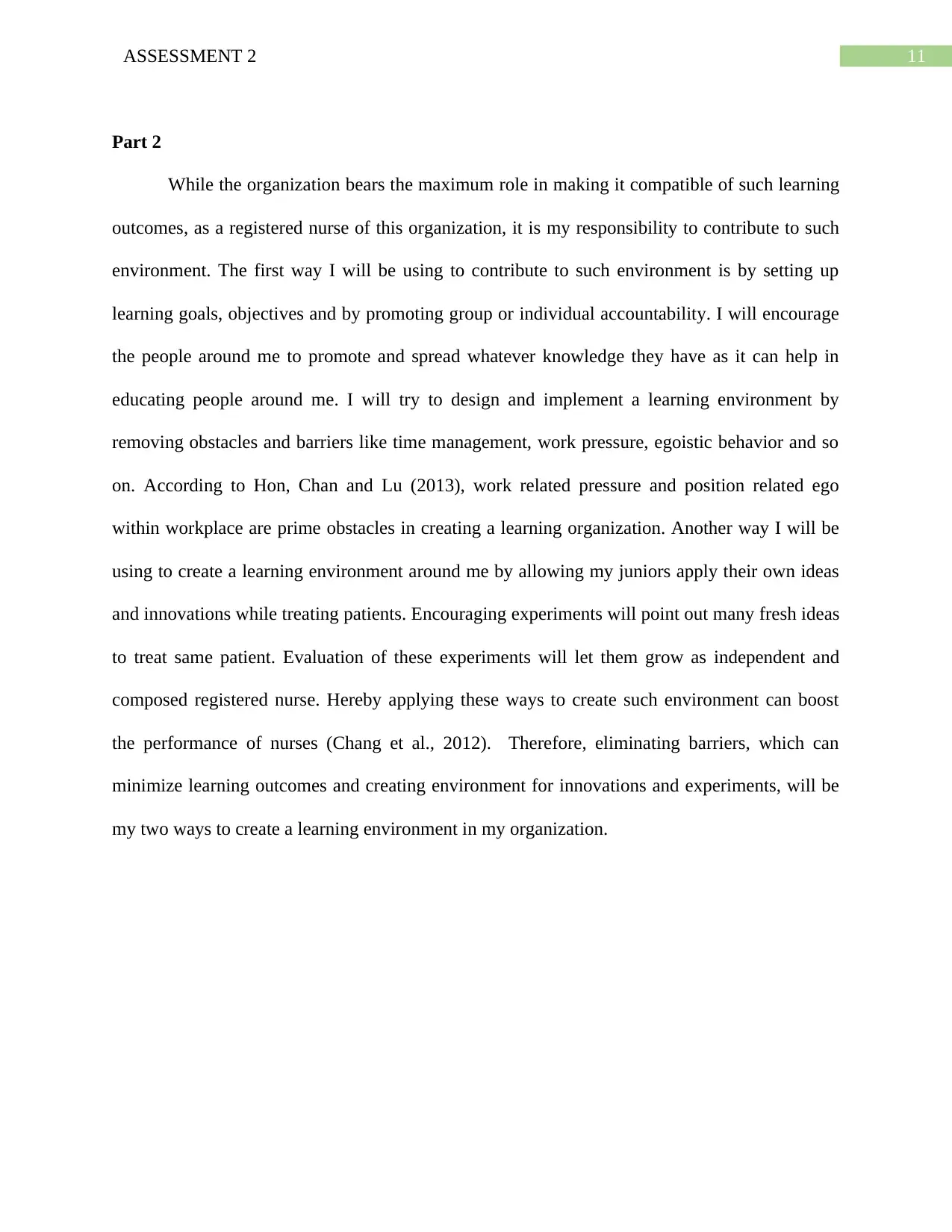
11ASSESSMENT 2
Part 2
While the organization bears the maximum role in making it compatible of such learning
outcomes, as a registered nurse of this organization, it is my responsibility to contribute to such
environment. The first way I will be using to contribute to such environment is by setting up
learning goals, objectives and by promoting group or individual accountability. I will encourage
the people around me to promote and spread whatever knowledge they have as it can help in
educating people around me. I will try to design and implement a learning environment by
removing obstacles and barriers like time management, work pressure, egoistic behavior and so
on. According to Hon, Chan and Lu (2013), work related pressure and position related ego
within workplace are prime obstacles in creating a learning organization. Another way I will be
using to create a learning environment around me by allowing my juniors apply their own ideas
and innovations while treating patients. Encouraging experiments will point out many fresh ideas
to treat same patient. Evaluation of these experiments will let them grow as independent and
composed registered nurse. Hereby applying these ways to create such environment can boost
the performance of nurses (Chang et al., 2012). Therefore, eliminating barriers, which can
minimize learning outcomes and creating environment for innovations and experiments, will be
my two ways to create a learning environment in my organization.
Part 2
While the organization bears the maximum role in making it compatible of such learning
outcomes, as a registered nurse of this organization, it is my responsibility to contribute to such
environment. The first way I will be using to contribute to such environment is by setting up
learning goals, objectives and by promoting group or individual accountability. I will encourage
the people around me to promote and spread whatever knowledge they have as it can help in
educating people around me. I will try to design and implement a learning environment by
removing obstacles and barriers like time management, work pressure, egoistic behavior and so
on. According to Hon, Chan and Lu (2013), work related pressure and position related ego
within workplace are prime obstacles in creating a learning organization. Another way I will be
using to create a learning environment around me by allowing my juniors apply their own ideas
and innovations while treating patients. Encouraging experiments will point out many fresh ideas
to treat same patient. Evaluation of these experiments will let them grow as independent and
composed registered nurse. Hereby applying these ways to create such environment can boost
the performance of nurses (Chang et al., 2012). Therefore, eliminating barriers, which can
minimize learning outcomes and creating environment for innovations and experiments, will be
my two ways to create a learning environment in my organization.
⊘ This is a preview!⊘
Do you want full access?
Subscribe today to unlock all pages.

Trusted by 1+ million students worldwide
1 out of 16
Related Documents
Your All-in-One AI-Powered Toolkit for Academic Success.
+13062052269
info@desklib.com
Available 24*7 on WhatsApp / Email
![[object Object]](/_next/static/media/star-bottom.7253800d.svg)
Unlock your academic potential
Copyright © 2020–2025 A2Z Services. All Rights Reserved. Developed and managed by ZUCOL.





